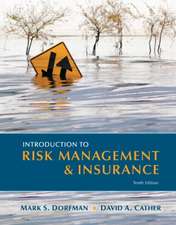Financial Risk Modelling and Portfolio Optimization with R 2e
Autor BEH Pfaffen Limba Engleză Hardback – 6 oct 2016
Bernhard Pfaff,Invesco Global Asset Allocation, Germany
A must have text for risk modelling and portfolio optimization using R.
This book introduces the latest techniques advocated for measuring financial market risk and portfolio optimization, and provides a plethora of R code examples that enable the reader to replicate the results featured throughout the book. This edition has been extensively revised to include new topics on risk surfaces and probabilistic utility optimization as well as an extended introduction to R language.
Financial Risk Modelling and Portfolio Optimization with R:
- Demonstrates techniques in modelling financial risks and applying portfolio optimization techniques as well as recent advances in the field.
- Introduces stylized facts, loss function and risk measures, conditional and unconditional modelling of risk; extreme value theory, generalized hyperbolic distribution, volatility modelling and concepts for capturing dependencies.
- Explores portfolio risk concepts and optimization with risk constraints.
- Is accompanied by a supporting website featuring examples and case studies in R.
- Includes updated list of R packages for enabling the reader to replicate the results in the book.
Graduate and postgraduate students in finance, economics, risk management as well as practitioners in finance and portfolio optimization will find this book beneficial. It also serves well as an accompanying text in computer–lab classes and is therefore suitable for self–study.
Preț: 655.64 lei
Preț vechi: 712.66 lei
-8% Nou
125.46€ • 131.93$ • 103.66£
Carte tipărită la comandă
Livrare economică 17 aprilie-01 mai
Specificații
ISBN-10: 1119119669
Pagini: 446
Dimensiuni: 152 x 229 x 25 mm
Greutate: 0.68 kg
Ediția:2nd Edition
Editura: Wiley
Locul publicării:Chichester, United Kingdom
Public țintă
Primary Market: Practitioners in finance and portfolio optimisation who are well versed in risk management and using R Secondary Market: Graduate and postgraduate students in finance, economics, risk managementDescriere
Financial Risk Modelling and Portfolio Optimization with R, 2nd Edition
Bernhard Pfaff, Invesco Global Asset Allocation, Germany
A must have text for risk modelling and portfolio optimization using R.
This book introduces the latest techniques advocated for measuring financial market risk and portfolio optimization, and provides a plethora of R code examples that enable the reader to replicate the results featured throughout the book. This edition has been extensively revised to include new topics on risk surfaces and probabilistic utility optimization as well as an extended introduction to R language.
Financial Risk Modelling and Portfolio Optimization with R:
- Demonstrates techniques in modelling financial risks and applying portfolio optimization techniques as well as recent advances in the field.
- Introduces stylized facts, loss function and risk measures, conditional and unconditional modelling of risk; extreme value theory, generalized hyperbolic distribution, volatility modelling and concepts for capturing dependencies.
- Explores portfolio risk concepts and optimization with risk constraints.
- Is accompanied by a supporting website featuring examples and case studies in R.
- Includes updated list of R packages for enabling the reader to replicate the results in the book.
Graduate and postgraduate students in finance, economics, risk management as well as practitioners in finance and portfolio optimization will find this book beneficial. It also serves well as an accompanying text in computer–lab classes and is therefore suitable for self–study.
Textul de pe ultima copertă
Financial Risk Modelling and Portfolio Optimization with R, 2nd Edition
Bernhard Pfaff, Invesco Global Asset Allocation, Germany
A must have text for risk modelling and portfolio optimization using R.
This book introduces the latest techniques advocated for measuring financial market risk and portfolio optimization, and provides a plethora of R code examples that enable the reader to replicate the results featured throughout the book. This edition has been extensively revised to include new topics on risk surfaces and probabilistic utility optimization as well as an extended introduction to R language.
Financial Risk Modelling and Portfolio Optimization with R:
- Demonstrates techniques in modelling financial risks and applying portfolio optimization techniques as well as recent advances in the field.
- Introduces stylized facts, loss function and risk measures, conditional and unconditional modelling of risk; extreme value theory, generalized hyperbolic distribution, volatility modelling and concepts for capturing dependencies.
- Explores portfolio risk concepts and optimization with risk constraints.
- Is accompanied by a supporting website featuring examples and case studies in R.
- Includes updated list of R packages for enabling the reader to replicate the results in the book.
Graduate and postgraduate students in finance, economics, risk management as well as practitioners in finance and portfolio optimization will find this book beneficial. It also serves well as an accompanying text in computer–lab classes and is therefore suitable for self–study.
Cuprins
Preface to the Second Edition xi
Preface xiii
Abbreviations xv
About the Companion Website xix
PART I MOTIVATION 1
1 Introduction 3
Reference 5
2 A brief course in R 6
2.1 Origin and development 6
2.2 Getting help 7
2.3 Working with R 10
2.4 Classes, methods, and functions 12
2.5 The accompanying package FRAPO 22
References 28
3 Financial market data 29
3.1 Stylized facts of financial market returns 29
3.1.1 Stylized facts for univariate series 29
3.1.2 Stylized facts for multivariate series 32
3.2 Implications for risk models 35
References 36
4 Measuring risks 37
4.1 Introduction 37
4.2 Synopsis of risk measures 37
4.3 Portfolio risk concepts 42
References 44
5 Modern portfolio theory 46
5.1 Introduction 46
5.2 Markowitz portfolios 47
5.3 Empirical mean–variance portfolios 50
References 52
PART II RISK MODELLING 55
6 Suitable distributions for returns 57
6.1 Preliminaries 57
6.2 The generalized hyperbolic distribution 57
6.3 The generalized lambda distribution 60
6.4 Synopsis of R packages for GHD 66
6.4.1 The package fBasics 66
6.4.2 The package GeneralizedHyperbolic 67
6.4.3 The package ghyp 69
6.4.4 The package QRM 70
6.4.5 The package SkewHyperbolic 70
6.4.6 The package VarianceGamma 71
6.5 Synopsis of R packages for GLD 71
6.5.1 The package Davies 71
6.5.2 The package fBasics 72
6.5.3 The package gld 73
6.5.4 The package lmomco 73
6.6 Applications of the GHD to risk modelling 74
6.6.1 Fitting stock returns to the GHD 74
6.6.2 Risk assessment with the GHD 77
6.6.3 Stylized facts revisited 80
6.7 Applications of the GLD to risk modelling and data analysis 82
6.7.1 VaR for a single stock 82
6.7.2 Shape triangle for FTSE 100 constituents 84
References 86
7 Extreme value theory 89
7.1 Preliminaries 89
7.2 Extreme value methods and models 90
7.2.1 The block maxima approach 90
7.2.2 The rth largest order models 91
7.2.3 The peaks–over–threshold approach 92
7.3 Synopsis of R packages 94
7.3.1 The package evd 94
7.3.2 The package evdbayes 95
7.3.3 The package evir 96
7.3.4 The packages extRemes and in2extRemes 98
7.3.5 The package fExtremes 99
7.3.6 The package ismev 101
7.3.7 The package QRM 101
7.3.8 The packages Renext and RenextGUI 102
7.4 Empirical applications of EVT 103
7.4.1 Section outline 103
7.4.2 Block maxima model for Siemens 103
7.4.3 r–block maxima for BMW 107
7.4.4 POT method for Boeing 110
References 115
8 Modelling volatility 116
8.1 Preliminaries 116
8.2 The class of ARCH models 116
8.3 Synopsis of R packages 120
8.3.1 The package bayesGARCH 120
8.3.2 The package ccgarch 121
8.3.3 The package fGarch 122
8.3.4 The package GEVStableGarch 122
8.3.5 The package gogarch 123
8.3.6 The package lgarch 123
8.3.7 The packages rugarch and rmgarch 125
8.3.8 The package tseries 127
8.4 Empirical application of volatility models 128
References 130
9 Modelling dependence 133
9.1 Overview 133
9.2 Correlation, dependence, and distributions 133
9.3 Copulae 136
9.3.1 Motivation 136
9.3.2 Correlations and dependence revisited 137
9.3.3 Classification of copulae 139
9.4 Synopsis of R packages 142
9.4.1 The package BLCOP 142
9.4.2 The package copula 144
9.4.3 The package fCopulae 146
9.4.4 The package gumbel 147
9.4.5 The package QRM 148
9.5 Empirical applications of copulae 148
9.5.1 GARCH copula model 148
9.5.2 Mixed copula approaches 155
References 157
PART III PORTFOLIO OPTIMIZATION APPROACHES 161
10 Robust portfolio optimization 163
10.1 Overview 163
10.2 Robust statistics 164
10.2.1 Motivation 164
10.2.2 Selected robust estimators 165
10.3 Robust optimization 168
10.3.1 Motivation 168
10.3.2 Uncertainty sets and problem formulation 168
10.4 Synopsis of R packages 174
10.4.1 The package covRobust 174
10.4.2 The package fPortfolio 174
10.4.3 The package MASS 175
10.4.4 The package robustbase 176
10.4.5 The package robust 176
10.4.6 The package rrcov 178
10.4.7 Packages for solving SOCPs 179
10.5 Empirical applications 180
10.5.1 Portfolio simulation: robust versus classical statistics 180
10.5.2 Portfolio back test: robust versus classical statistics 186
10.5.3 Portfolio back–test: robust optimization 190
References 195
11 Diversification reconsidered 198
11.1 Introduction 198
11.2 Most–diversified portfolio 199
11.3 Risk contribution constrained portfolios 201
11.4 Optimal tail–dependent portfolios 204
11.5 Synopsis of R packages 207
11.5.1 The package cccp 207
11.5.2 The packages DEoptim, DEoptimR, and RcppDE 207
11.5.3 The package FRAPO 210
11.5.4 The package PortfolioAnalytics 211
11.6 Empirical applications 212
11.6.1 Comparison of approaches 212
11.6.2 Optimal tail–dependent portfolio against benchmark 216
11.6.3 Limiting contributions to expected shortfall 221
References 226
12 Risk–optimal portfolios 228
12.1 Overview 228
12.2 Mean–VaR portfolios 229
12.3 Optimal CVaR portfolios 234
12.4 Optimal draw–down portfolios 238
12.5 Synopsis of R packages 241
12.5.1 The package fPortfolio 241
12.5.2 The package FRAPO 243
12.5.3 Packages for linear programming 245
12.5.4 The package PerformanceAnalytics 249
12.6 Empirical applications 251
12.6.1 Minimum–CVaR versus minimum–variance portfolios 251
12.6.2 Draw–down constrained portfolios 254
12.6.3 Back–test comparison for stock portfolio 260
12.6.4 Risk surface plots 265
References 272
13 Tactical asset allocation 274
13.1 Overview 274
13.2 Survey of selected time series models 275
13.2.1 Univariate time series models 275
13.2.2 Multivariate time series models 281
13.3 The Black Litterman approach 289
13.4 Copula opinion and entropy pooling 292
13.4.1 Introduction 292
13.4.2 The COP model 292
13.4.3 The EP model 293
13.5 Synopsis of R packages 295
13.5.1 The package BLCOP 295
13.5.2 The package dse 297
13.5.3 The package fArma 300
13.5.4 The package forecast 301
13.5.5 The package MSBVAR 302
13.5.6 The package PortfolioAnalytics 304
13.5.7 The packages urca and vars 304
13.6 Empirical applications 307
13.6.1 Black Litterman portfolio optimization 307
13.6.2 Copula opinion pooling 313
13.6.3 Entropy pooling 318
13.6.4 Protection strategies 324
References 334
14 Probabilistic utility 339
14.1 Overview 339
14.2 The concept of probabilistic utility 340
14.3 Markov chain Monte Carlo 342
14.3.1 Introduction 342
14.3.2 Monte Carlo approaches 343
14.3.3 Markov chains 347
14.3.4 Metropolis Hastings algorithm 349
14.4 Synopsis of R packages 354
14.4.1 Packages for conducting MCMC 354
14.4.2 Packages for analyzing MCMC 358
14.5 Empirical application 362
14.5.1 Exemplary utility function 362
14.5.2 Probabilistic versus maximized expected utility 366
14.5.3 Simulation of asset allocations 369
References 375
Appendix A Package overview 378
A.1 Packages in alphabetical order 378
A.2 Packages ordered by topic 382
References 386
Appendix B Time series data 391
B.1 Date/time classes 391
B.2 The ts class in the base package stats 395
B.3 Irregularly spaced time series 395
B.4 The package timeSeries 397
B.5 The package zoo 399
B.6 The packages tframe and xts 401
References 404
Appendix C Back–testing and reporting of portfolio strategies 406
C.1 R packages for back–testing 406
C.2 R facilities for reporting 407
C.3 Interfacing with databases 407
References 408
Appendix D Technicalities 411
Reference 411
Index 413





















